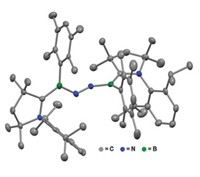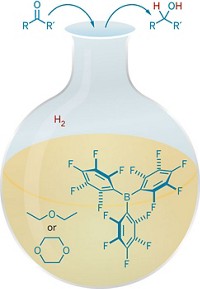Advertisement
Grab your lab coat. Let's get started
Welcome!
Welcome!
Create an account below to get 6 C&EN articles per month, receive newsletters and more - all free.
It seems this is your first time logging in online. Please enter the following information to continue.
As an ACS member you automatically get access to this site. All we need is few more details to create your reading experience.
Not you? Sign in with a different account.
Not you? Sign in with a different account.
ERROR 1
ERROR 1
ERROR 2
ERROR 2
ERROR 2
ERROR 2
ERROR 2
Password and Confirm password must match.
If you have an ACS member number, please enter it here so we can link this account to your membership. (optional)
ERROR 2
ACS values your privacy. By submitting your information, you are gaining access to C&EN and subscribing to our weekly newsletter. We use the information you provide to make your reading experience better, and we will never sell your data to third party members.
Synthesis
Stable Carbenes Split Ammonia, Hydrogen
The push is on to make the process catalytic
by Ron Dagani
April 20, 2007
Chemists have long dreamed about inventing a catalytic system that can efficiently transform ammonia into useful amino compounds, which are building blocks for myriad substances ranging from proteins to pharmaceuticals. Researchers at the University of California, Riverside, have taken what may be a first step toward realizing that goal by discovering a new way to split ammonia, hydrogen, and other small molecules.
Traditionally, transition-metal complexes have been used to chemically activate, or cleave, small molecules such as H2 and NH3, although very few examples of NH3 splitting have been reported. Some nonmetallic systems, such as those involving a phosphine and a borane, also have been found to cleave H2 under mild conditions.
The UC Riverside team, led by Guy Bertrand, in collaboration with Wolfgang W. Schoeller, focused instead on stable carbenes: organic molecules that contain a divalent carbon atom that has a lone pair of electrons in a nonbonding orbital. Bertrand's group has been studying stable carbenes for almost two decades. They now report that certain carbenes—those in which the carbene center (the divalent carbon atom) is sandwiched between an amine group and an alkyl group—have just enough nucleophilicity to cleave H2 and NH3. The resulting fragments (H and/or NH2) become attached to the carbene center. With liquid ammonia, the reaction occurs in high yield at temperatures around ???40 oC, the researchers report today (Science 2007, 316, 439).
Although the paper deals only with hydrogen and ammonia activation, Bertrand tells C&EN that the carbenes also can activate other small molecules such as silane (SiH4), phosphines, and P4.
"The carbene is doing the job of a metal," Bertrand says. And just as with metals, it's possible to tune the reactivity and properties of the carbene by modifying its substituents, he adds.
Bertrand points out that it's difficult to split NH3 using a transition metal. Because metals are electrophilic, the nitrogen lone pair of NH3 usually just coordinates to the metal center and no further reaction occurs. So carbenes may have an edge on metals in that respect.
But just adding H and NH2 to a carbene center isn't good enough for Bertrand. He wants to find a way to transfer these fragments from the carbene center to another molecule???say, an olefin???to make an amino compound and regenerate the carbene. "Our dream is to use the carbene as a catalyst," he says. If his team succeeds, there will be "thousands of applications," he promises.
Douglas W. Stephan, a chemistry professor at the University of Windsor, in Ontario, comments that Bertrand's discovery is "an extremely interesting initial observation and offers the possibility of a catalytic cycle???if he can find the right substrate" to accept those fragments and regenerate the carbene. The appeal of metal-free systems for catalysis, Stephan explains, is that they could lower the cost of synthesis and eliminate transition-metal residues in the product. The Riverside group's work "certainly points us in a new direction," he says.






Join the conversation
Contact the reporter
Submit a Letter to the Editor for publication
Engage with us on Twitter